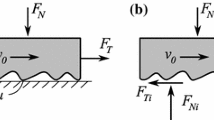Abstract
The dependence of rolling friction on velocity for various contact conditions is discussed. The principal difference between rolling and other types of relative motion (sliding and spinning) is that the points of the body in contact with the support change over time. Due to deformations, there is a small contact area and, entering into contact, the body points have a normal velocity proportional to the diameter of this area. For describing the dependence of the friction coefficient on the angular velocity in the case of “pure” rolling, a linear dependence is proposed that admits a logical explanation and experimental verification. Under the combined motion, the rolling friction retains its properties, the sliding and spinning friction acquiring the properties of viscous friction.
Similar content being viewed by others
REFERENCES
J. Y. Wong, Theory of Ground Vehicles, 3d ed. (Wiley, N.Y., 2001)
R. I. Leine, Arch. Appl. Mech. 79 (11), 1063 (2009).
A. V. Borisov, A. A. Kilin, and Yu. L. Karavaev, Usp. Fiz. Nauk 187 (9), 1003 (2017).
A. A. Kireenkov, Dokl. Phys. 53 (4), 233 (2008).
A. V. Karapetyan, Prikl. Mat. Mekh. 73 (4), 515 (2009).
K. T. McDonald, RCD 13 (4), 332 (2008).
A. M. Formal’skii, Displacement of Anthropomorphic Mechanisms (Nauka, M., 1982) [in Russian].
P. Kontensu, Relationship between Sliding Friction and Spinning Friction and Its Taking into Account in Theory of Top. Problems of Gyroscopy (Mir, M., 1967) [in Russian].
D. Ma, C. Liu, Z. Zhao, and H. Zhang, Proc. R. Soc. A 470, 20140191 (2014).
I. G. Goriacheva, J. Appl. Math. and Mech. 37 (5), 925 (1973);
I. G. Goryacheva, Prikl. Mat. Mekh. 37 (5), 877 (1973).
S. C. Hunter, J. Appl. Mech. 28 (4), 611 (1961).
B. N. J. Persson, The Europ. Phys. J. E 33 (4), 327 (2010).
A. V. Borisov, T. B. Ivanova, Y. L. Karavaev, and I. S. Mamaev, Europ. J. Phys. 39 (6), 065001 (2018).
A. V. Borisov, A. A. Kilin, and I. S. Mamaev, Reg. and Chaot. Dyn. 18 (1/2), 144 (2013).
J. Svendenius, Tire Models for Use in Braking Application (Lund: Dept. Autom. Control, Lund Inst. Technol., 2003).
Author information
Authors and Affiliations
Corresponding author
Additional information
Translated by V. Bukhanov
Rights and permissions
About this article
Cite this article
Ivanov, A.P. Rolling Friction. Dokl. Phys. 64, 129–133 (2019). https://doi.org/10.1134/S1028335819030157
Received:
Published:
Issue Date:
DOI: https://doi.org/10.1134/S1028335819030157



